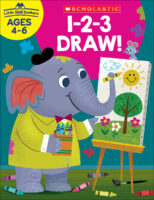By playing word games with your child, you not only spend precious time together, but you demonstrate that playing with words is lots of fun! All the word games you'll find below require minimal (if any!) equipment. Play them on the way to school, on weeknights before bed, or any other time you have 15 minutes spare.
Guess the animal: Give your child a rhyming word and have them guess the animal. "I rhyme with mat. I am a …" "I rhyme with log. I am a..." "I rhyme with now. I am a..." and so on.
I spy: This is a simple word game most people know. Spot something nearby and tell your child the sound or letter it begins with. They must look around and try to guess what it is you "spied."
Does your child love playing I spy? Then check out all the books in the I Spy series.
Make a word: If you have plastic letters, magnet letters, or letter blocks, you can play this as soon as your child is old enough to spell. Play it mentally with older kids, or with paper and pencil. Simply give your children some letters and challenge them to make words from those letters. This one is a great gateway into board games like Scrabble.
Categories: Simply draw a grid on a piece of paper. Then write some categories (for instance "plants," "girls' names," "cars," "grocery items") down one side of the grid and write alphabet letters across the top. It needn't be the whole alphabet. The aim is to try to think up a word for each letter and category.
Hink Pink: Kids adore this game! One person thinks of two-single syllable rhyming words, like fat cat. She works out a clue that should lead (eventually!) to the answer "fat cat." One clue could be "an obese mouse-catcher" or "a pet that eats too much," depending on the age of the guesser. The guesser tries to work out what the two rhyming words are. The game can be extended to Hinky Pinky (two syllable rhyming words), like happy chappy = "joyful fellow." Or Hinketty Pinketty (three syllable rhyming words, much harder), like mellower bellower = "less angry bull." Mix and match with Hinky Pinketty or Hinketty Pink!
Here are some Hink Pinks you can use to get you and your child started.
Clues 1. seafood platter 2. huge oinker 3. head cover that's been squashed by a truck 4. warmed up joint between two ropes 5. Rained-on puppy
Answers 1. fish dish 2. big pig 3. flat hat 4. hot knot 5. wet pet
If your child has trouble working out how many syllables are in a word, play a game where you tap the syllables on her arm as you slowly say the word: "butt(tap)-er (tap)-fly(tap)." Or march and dance the words, making strong body movements for each syllable. There is nothing more joyous than the sight and sound of 30 youngsters marching about, chanting the syllables in given words!
Once older kids are used to the game, it can provide a lead-in to crossword puzzles, and then cryptic crossword puzzles. All of these word games are great for developing thinking skills, as well as giving the whole family a way of celebrating the joy of language.
We also reached out to Scholastic Teacher Fellows Alexandra Felix and Milagros Sanchez-Cohen to ask if they had any favorite word games that they use in the classroom. Here's what they suggested:
Hot Seat: "To play this game, I have one student sit in a chair at the front of the classroom, facing their peers. I display a picture on the Smartboard behind the chosen student so they cannot see. The rest of the class sees the picture and must think of ways to describe it so the selected student can guess what it is. This could be anything: an animal, a game, a food. The students take turns giving the chosen student guesses. They have to describe the picture as best as they can. Since I work with English Language Learners, I allow my newcomers to describe their clues in their language and another student translates for them. I also provide sentence starters to help them practice saying their clues in English. I only have a few rules: the students giving the clues cannot say what letters are in the word and they cannot say words that rhyme with the picture. This is to help them strengthen their ability to describe, rather than rely on sounds or letters in the words.
"The students love this game and it's very easy to play at home! This game helps kids learn how to use adjectives to describe, for example. The game also enriches students' knowledge. For example, if I show a bat on the Smartboard, one student might describe the animal as having fur. Another student might describe the animal as being a mammal. Some students might not know what a mammal is, so this is a great opportunity to teach and discuss what mammals are. This helps to expand knowledge of different topics, such as bats." – Alexandra Felix
Sight Word Tic-Tac-Toe: "This game can be played by making a tic-tac-toe board. In each space, think of nine sight words your child is learning at school or in a book at home, and add them to the board. Add an 'X' or an 'O' over each word as you read it aloud until someone gets tic-tac-toe or three in a row. The game's benefit is for the child to recognize the sight word, read it aloud, and practice making a match with three in a row." – Milagros Sanchez-Cohen
Shop for fun workbooks, books that teach reading and sounds, and more below! You can find all books and activities at The Scholastic Store.






















